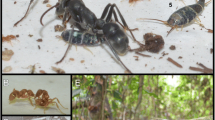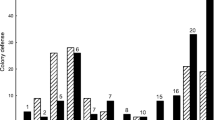Summary
During agonistic encounters, both minors and majors of the European ant P. pallidula actively cooperate in defense. Minors seize the legs of the intruder and in some cases induce the recruitment of nestmates whereas majors kill the spreadeagled alien ant. The defensive strategy of P. pallidula is very flexible and adapted to both the number of alient ants and to the intruder's superiority in fighting. On the one hand, only a massive invasion of alien minors results in a slow mobilization of resident ants to the combat area, elicited by recruiters performing weak tactile invitations and trail-laying behavior. On the other hand, the presence of 10 majors induces a fast and massive recruitment achieved by intense trail-laying and tactile invitations from the recruiters. Because of their high response threshold to invitations, resident majors are mobilized only during these intense recruitments, their exit being additionally enhanced by their preferential stimulation. The adaptiveness of this defensive strategy is discussed. It is also suggested that simple decision-making rules of recruitment and caste differences in behavioral thresholds could account for the complexity of P. pallidula defensive strategies.
Similar content being viewed by others
References
Ali MF, Morgan ED, Detrain C, Attygale AB (1988) Identification of a component of the trail pheromone of the ant Pheidole pallidula (Hymenoptera: Formicidae). Physiol Entomol 13:257–265
Buckingham E (1911) Division of labor among ants. Proc Am Acad Arts Sci 46:425–507
Busher CE, Calabi P, Traniello JF (1985) Polymorphism and division of labor in the Neotropical ant Camponotus sericeiventris Guerin (Hymenoptera: Formicidae). Ann Entomol Soc Am 78:221–228
Calabi P (1988) Behavioral flexibility in Hymenoptera: a re-examination of the concept of caste. In: Trager J (ed) Advances in myrmecology. Brill, Leiden, pp 237–258
Calabi P, Traniello J, Werner M (1984) Age polyethism: its occurrence in the ant Pheidole hortensis and some general considerations. Psyche 90:395–412
Carlin NF (1981) Polymorphism and division of labor in the Dacetine ant Orectognathus versicolor (Hymenoptera: Formicidae). Psyche 88:231–244
Carlin NF, Johnston AB (1984) Learned enemy specification in the defense recruitment system of an ant. Naturwissenschaften 71:156–157
Creighton WS (1966) The habits of Pheidole ridicula Wheeler with remarks on habit patterns in the genus Pheidole (Hymenoptera: Formicidae). Psyche 73:1–7
Creighton WS, Creighton MP (1959) The habits of Pheidole militicida Wheeler (Hymenoptera: Formicidae). Psyche 66:1–12
Detrain C, Pasteels JM (1987) Morphological and biochemical differences in the abdominal glands of Pheidole pallidula. In: Eder J, Rembold H (eds) Chemistry and biology of social insects. Peperny, München, pp 447–448
Detrain C, Pasteels JM (1991) Caste differences in behavioral thresholds as a basis for polyethism during food recruitment in the ant Pheidole pallidula (Nyl.). J Insect Behav 4:157–176
Detrain C, Pasteels JM, Deneubourg JL, Goss S (1990) Prey foraging by the ant Pheidole pallidula: decision-making systems in food recruitments. In: Veeresh G, Mallik B, Viraktamath C (eds) Social insects and the environment. Oxford, New Delhi, pp 550–551
Feener DH (1986) Alarm-recruitment behavior in Pheidole militicida (Hymenoptera: Formicidae). Ecol Entomol 11:67–74
Fowler HG (1984) Recruitment, group retrieval and major worker behavior in Pheidole oxyops Forel (Hymenoptera: Formicidae). Rev Brasil Biol 44:21–24
Goetsch W (1953) Vergleichende Biologie der Insekten-Staaten. Akademische Verlagsgesellschaft, Geest & Portig, Leipzig
Johnston AB, Wilson EO (1985) Correlates of variation in the major/minor ratio of the ant Pheidole dentata (Hymenoptera: Formicidae). Ann Entomol Soc Am 78:8–11
Ono S (1984) A preliminary study of the effect of the existence of competitor on the soldier production in the ant Pheidole fervida Smith (Hymenoptera: Formicidae). Kontyû 52:332–334
Oster GF, Wilson EO (1978) Caste and ecology in the social insects. Princeton University Press, Princeton
Passera L (1974) Diffé6renciation des soldats chez la fourmi Pheidole pallidula. Nyl. (Formicidae, Myrmicinae). Insectes Soc 21:71–86
Pasteels JM, Deneubourg JL, Goss S (1987) Self-organization mechanisms in ant societies (I). Trail recruitment to newly discovered food sources. In: Pasteels JM and Deneubourg JL (eds) From individual to collective behavior in social insects. Birkhaüser, Basel-Boston, pp 155–176
Szlep-Fessel R (1970) The regulatory mechanism in mass foraging and the recruitment of soldiers in Pheidole. Insectes Soc 17(4):233–244
Whitford WG, Depree DJ, Hamilton P, Ettershank G (1981) Foraging ecology of seed-harvesting ants, Pheidole spp., in a Chihuahuan desert ecosystem. Am Midl Nat 105:159–167
Wilson EO (1975) Enemy specification in the alarm-recruitment system of an ant. Science 190:798–800
Wilson EO (1976) The organization of colony defense in the ant Pheidole dentata Mayr (Hymenoptera: Formicidae). Behav Ecol Sociobiol 1:63–81
Wilson EO (1985) Between-caste aversion as a basis for division of labor in the ant Pheidole pubiventris (Hymenoptera Formicidae). Behav Ecol Sociobiol 17:35–37
Wilson EO (1986) Caste and division of labor in Erebomyrma, a genus of dimorphic ants (Hymenoptera: Formicidae: Myrmicinae). Insectes Soc 33:59–69
Wilson EO, Holldobler B (1985) Caste-specific techniques of defense in the polymorphic ant Pheidole embolopyx (Hymenoptera: Formicidae). Insectes Soc 32:3–22
Wilson EO, Holldobler B (1988) Dense heterarchics and mass communication as the basis of organization in ant colonies. Trends Ecol Evol 3:65–68
Author information
Authors and Affiliations
Additional information
Senior Research Assistant at Belgian National Fund for Scientific Research
Offprint requests to: C. Detrain
Rights and permissions
About this article
Cite this article
Detrain, C., Pasteels, J.M. Caste polyethism and collective defense in the ant, Pbeidole pallidula: the outcome of quantitative differences in recruitment. Behav Ecol Sociobiol 29, 405–412 (1992). https://doi.org/10.1007/BF00170170
Received:
Accepted:
Issue Date:
DOI: https://doi.org/10.1007/BF00170170




